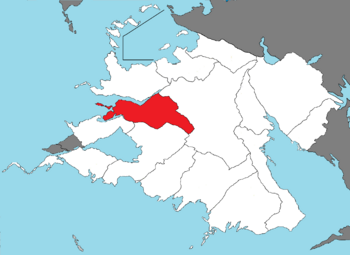Redeemer’s Land: Difference between revisions
No edit summary |
No edit summary |
||
| Line 92: | Line 92: | ||
}} | }} | ||
'''Redeemer's Land''' is an [[Administrative District (Zamastan)|Administrative District (Province)]] of [[Zamastan]]. | '''Redeemer's Land''' is an [[Administrative District (Zamastan)|Administrative District (Province)]] of [[Zamastan]]. Redeemer's Land has been home to many [[Catica First Nations|Indigenous nations]] for thousands of years. The first [[Adula]]n traders, explorers, and settlers began exploring what is now the province's [[Olympic Ocean]] coast in the early-mid 1500s. As early as 1565, the [[Skith]]ans and [[Quetana]]ns began sending vessels east from the [[Caspia]] Islands. | ||
In 1821, an autonomous government was formed in the Redeemer's Country, and the Territory was added to the country of Zamastan with the [[Moulins Purchase of 1831]]. Today, with 15 million people, Redeemer's Land is the 11th most populous province. The capital, [[Moulins]], is the most populous city in the province, with 996,000 residents. | |||
Redeemer's Land is one of the most geographically diverse provinces, marked by volcanoes, abundant bodies of water, dense evergreen and mixed forests. At 11,249 feet (3,429 m), Mount Earbast, a stratovolcano, is the province's highest point. Because of its diverse landscapes and waterways, Redeemer's Land's economy is largely powered by various forms of agriculture, fishing, and hydroelectric power. Redeemer's Land is also the top timber producer of the contiguous Zamastanian provinces, and the timber industry dominated the province's economy in the 20th century. | |||
==Etymology== | ==Etymology== | ||
Revision as of 03:12, 22 August 2020
Redeemer's Land | |
|---|---|
 Redeemer's Land located in Zamastan | |
| Capital | Moulins |
| Government | |
• Governor | Huw Hayes |
| Population | |
• Estimate | 15,241,000 |
Redeemer's Land is an Administrative District (Province) of Zamastan. Redeemer's Land has been home to many Indigenous nations for thousands of years. The first Adulan traders, explorers, and settlers began exploring what is now the province's Olympic Ocean coast in the early-mid 1500s. As early as 1565, the Skithans and Quetanans began sending vessels east from the Caspia Islands.
In 1821, an autonomous government was formed in the Redeemer's Country, and the Territory was added to the country of Zamastan with the Moulins Purchase of 1831. Today, with 15 million people, Redeemer's Land is the 11th most populous province. The capital, Moulins, is the most populous city in the province, with 996,000 residents.
Redeemer's Land is one of the most geographically diverse provinces, marked by volcanoes, abundant bodies of water, dense evergreen and mixed forests. At 11,249 feet (3,429 m), Mount Earbast, a stratovolcano, is the province's highest point. Because of its diverse landscapes and waterways, Redeemer's Land's economy is largely powered by various forms of agriculture, fishing, and hydroelectric power. Redeemer's Land is also the top timber producer of the contiguous Zamastanian provinces, and the timber industry dominated the province's economy in the 20th century.
